
Exporting cut flowers
Date: 21 Oct 2002 Author: Bettina Gollnow
The global flower trade
Australia is now an integral part of the expanding world flower trade, which, in 2000, was worth an estimated US$7 billion. Over 65 countries are involved in the international trade in cut flowers and foliages. The main countries exporting fresh flowers are:
- the Netherlands
- Colombia
- Israel
- Ecuador
- Spain
- Italy.
The value of the Australian cut flower industry is estimated to be less than 1% of total world trade.
Commercial flower growers with an export focus are in the minority — most growers in Australia produce traditional flowers, and 90% of flowers produced are sold on the domestic market.
Australia’s flower export potential
Australia’s potential for exporting flowers lies in its unique native flora, a rich resource of valuable new flower products waiting to be fully developed and marketed to the world. The true value of the Australian export industry is not clearly defined but is likely to be greater than published estimates, currently around A$50 million per annum.
We compete with Israel and USA (California), as well as South African and South American countries. Compared with Australia, these countries often enjoy lower labour costs, abundant labour pools, close proximity to major markets, subsidised air freight and preferential tariffs and other duties. In order to survive, Australian growers and exporters must therefore be committed to quality and service.
Australian native flowers, South African proteaceae and foliage lines account for around 95% of all Australian flower exports. The ‘top ten’ are:
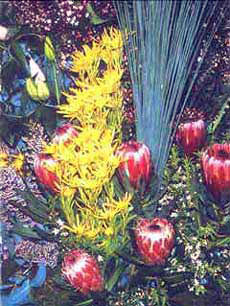
- waxflower (Chamelaucium spp.)
- kangaroo paw (Anigozanthos spp.)
- thryptomene (Thryptomene spp.)
- stirlingia (Stirlingia spp.)
- protea (Protea spp.)
- banksia (Banksia spp.)
- leucadendron (Leucadendron spp.)
- koala fern (Caustis spp.)
- scholtzia (Scholtzia spp.)
-
eucalytpus foliage (Eucalyptus spp.).
The Australian native flower and protea industry is relatively young but has already demonstrated its potential, with an ability to produce new flower varieties and colours over an extended season as new production regions are established. However, the supply of new products is critical to the industry’s survival, as is its ability to be increasingly competitive on the world market. A number of research projects are underway around the country to select and develop improved forms and new species for floriculture. (For more information see the website of the Rural Industries Research and Development Corporation.)
Many native flowers and proteas cannot be grown all year round. However, Australia’s range of climatic zones means that there is the potential to extend the availability of high-demand lines. In addition, Australian growers can produce crops ‘out of season’ from a Northern Hemisphere producer perspective.
Traditional flowers account for less than 5% of total flower exports from Australia. Though there is huge competition worldwide, the trade could develop further by targeting specific markets. Timing and quality are two factors critical to exploiting niche markets successfully.
The NSW industry
The New South Wales cut flower industry has an estimated farm gate value of A$202.7 million a year, with most produce selling on the domestic market. Native and South African flowers account for about 10–15% of total domestic sales.
Cut flower production for export is concentrated along the coastal strip. Here, excellent growing conditions and transport links provide access to major export markets via Sydney and Brisbane, which have the advantage of direct flights to Japan. Farms located on the North Coast (Kempsey and northwards) come into production at a key time to satisfy prime market opportunities in Japan.
There is also significant interest in cut flower production in inland New South Wales, specifically the Central West region and northern New South Wales.
A number of native species with proven export demand grow naturally in NSW. These include:
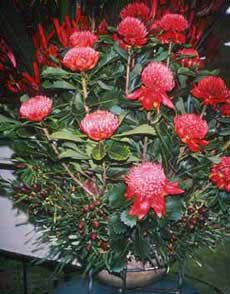
Waratah
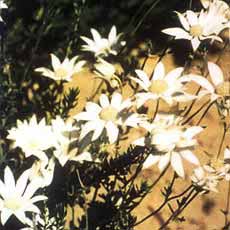
Flannel flowers
- waratah (Telopea speciosissima) (pictured right)
- Gymea lily (Doryanthes excelsa)
- Austral eriostemon (Eriostemon australasius)
- flannel flower (Actinotus helianthi)
- festival bush or Christmas bush (Ceratopetalum gummiferum).
NSW growers currently export a variety of lines, including:
- flannel flower (Actinotis spp.) (pictured right)
- kangaroo paw (Anigozanthos spp.)
- boronia (Boronia spp.)
- festival bush (Ceratopetalum gummiferum)
- waxflower (Chamelaucium spp.)
- crowea (Crowea spp.)
- corroboree bush (Cryptandra scortechinii)
- giant lily (Doryanthes spp.)
- riceflower (Ozothamnus spp.)
- proteas (Protea spp.)
- waratahs (Telopea spp.).
Major markets
Over 50% of Australia’s total flower exports are destined for markets in Japan and up to 30% sell to North America (mostly the US). Other important markets are the Netherlands (11%) and Germany (3%).
Within the next 30 years, Asia will represent the largest consumer market in the world. There is potential to expand into new Asian markets with perhaps the most significant being China where a very small rise in per capita consumption will translate into large sales.
Japan
Japan remains the largest single market for Australian-grown flowers, although recent years have seen increasing demand from the US for Australian flowers. Most flowers are distributed through the auction system, which means that the sale price is not known until after the flowers are sold. Opportunities for Australian flowers rely on high-quality products, new products, and high-value products. Various native flowers and proteas offer the best prospects for growth.
United States
The USA is a large consumer market, and imports over half of the total floricultural products sold. While the market remains dominated by traditional flowers, there is a strong demand for high-quality Australian filler flowers such as waxflower. Other products like festival bush are developing their own niches in the USA market. Demand for foliages and bouquets is also increasing.
European Union
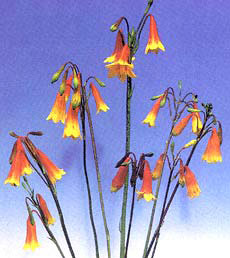
Christmas bells
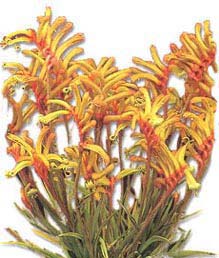
Kangaroo paws
Germany is the mainstay of international flower trade and is the biggest and most influential market in the EU.
The UK is currently the second largest importer of flower products and up to one-half of all flower sales are through supermarkets and chain stores.
Europe is a very competitive and quality-conscious market. Australia holds a niche market for high-quality banksia, New South Wales christmas bells, foliage, waxflower and kangaroo paw.
Production factors
New South Wales has a wide range of climates and soil types well suited to cut flower production. Areas along the coastal strip are especially suitable as they have a mild climate and summer rainfall. Most inland areas have a drier climate, predominantly winter rainfall, and are often subjected to winter frosts.
Inland growers should conduct comprehensive varietal trials to ensure suitability for their region.
Effects of climate and location on growth and flowering are not fully defined for all species. Some will not tolerate frosts more severe than –4°C. Local trials are strongly recommended in order to establish the best combination of species to plant.
Any farm site selected for cut flower growing should have:
- adequate quality water;
- well-drained soil, with a pH from 5.5–7.0;
- good access for machinery;
- plantation sites that face north, north-east or east;
- power for irrigation pumps, the coolroom, and the packing shed.
Infrastructure and support
Infrastructure requirements for a successful cut flower operation include:
- skilled labour for crop management, picking, grading, bunching and packing;
- technical advice on production, postharvest treatment (exported flowers may be in transit and out of water for up to 5 days before reaching the overseas consumer), and legal, financial, marketing aspects;
- adequate coolroom capacity;
- reliable supplies of quality planting stock;
- constant supplies of packaging materials;
- postharvest disinfestation facilities (many export destinations have a nil tolerance for pests and diseases);
- refrigerated transport to market/airport where appropriate;
- reliable freight forwarder;
- reliable specialist exporter.
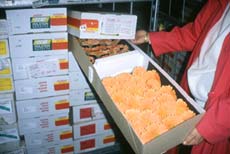
Cut flowers like these gerberas need to be
carefully packed if they are to be shipped
a long distance from grower to market.
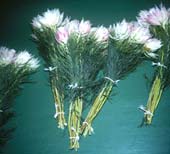
Bunches of serruria ready for packaging.
Limiting factors
Cut flower production is a specialist, capital-intensive industry, and careful consideration must be made by any investors. Factors which limit potential entrants to the industry include:
- expertise — entrants require some knowledge or staff with a background in flower production;
- capital — successful establishment of a viable cut flower operation requires a high initial capital flow and commitment for a number of years before returns are realistic. In recent times, rulings by the Australian Tax Office have required growers to demonstrate more clearly the lead time for a particular crop to become commercially viable;
- market research — a detailed understanding of key markets is crucial to exploit sales opportunities.
- scientific data — because of the native flower industry’s infancy, data about the suitability of varieties to certain situations and regions is patchy at best. More research needs to be conducted on potential new areas and varieties;
- economies of scale — while the industry has traditionally been served by a number of small operations, some people believe the future lies in larger producers with high capital and land investments who are able to take advantage of the obvious economies of scale as well as consistency of supply;
- success rate — the industry has a traditionally low success rate of new entrants, due mostly to the factors mentioned here. Effective quality management and marketing are extremely important.
Industry organisations
The Flower Export Council of Australia
The Flower Export Council of Australia (FECA) is an association of Australian floricultural exporters working together to address industry challenges and present a united focus in the marketing and promotion of their products overseas.
FECA has a long-term commitment to promoting Australian fresh and dried flowers and foliage to the flower markets of the world. FECA believes that fresh flower exports have grown particularly strongly since the 1999–2000 financial year. However, in world terms, our production of South African and Australian native crops is only some 10% of the total volume traded.
More information about flower products exported from Australia can be found in the booklet Flowers from Australia 2001–2002, available from FECA.

